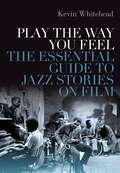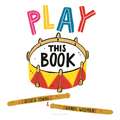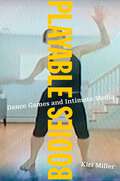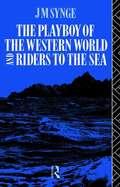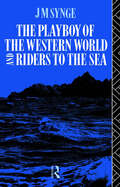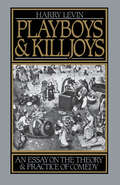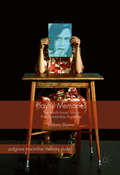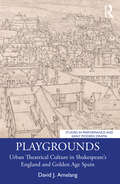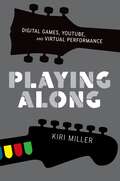- Table View
- List View
Play Readings: A Complete Guide for Theatre Practitioners
by Rob UrbinatiPlay Readings: A Complete Guide for Theatre Practitioners demystifies the standards and protocols of a play reading, demonstrating how to create effective and evocative readings for those new to or inexperienced with the genre. It examines all of the essential considerations involved in readings, including the use of the venue, pre-reading preparations, playwright/director communication, editing/adapting stage directions, casting, using the limited rehearsal time effectively, simple "staging" suggestions, working with actors, handling complex stage directions, talkbacks, and limiting the use of props, costumes, and music. A variety of readings are covered, including readings of musicals, operas, and period plays, for comprehensive coverage of this increasingly prevalent production form.
Play Readings: A Complete Guide for Theatre Practitioners
by Rob UrbinatiPlay Readings: A Complete Guide for Theatre Practitioners demystifies the standards and protocols of a play reading, demonstrating how to create effective and evocative readings for those new to or inexperienced with the genre. It examines all of the essential considerations involved in readings, including the use of the venue, pre-reading preparations, playwright/director communication, editing/adapting stage directions, casting, using the limited rehearsal time effectively, simple "staging" suggestions, working with actors, handling complex stage directions, talkbacks, and limiting the use of props, costumes, and music. A variety of readings are covered, including readings of musicals, operas, and period plays, for comprehensive coverage of this increasingly prevalent production form.
Play the Way You Feel: The Essential Guide to Jazz Stories on Film
by Kevin WhiteheadJazz stories have been entwined with cinema since the inception of jazz film genre in the 1920s, giving us origin tales and biopics, spectacles and low-budget quickies, comedies, musicals, and dramas, and stories of improvisers and composers at work. And the jazz film has seen a resurgence in recent years--from biopics like Miles Ahead and HBO's Bessie, to dramas Whiplash and La La Land. In Play the Way You Feel, author and jazz critic Kevin Whitehead offers a comprehensive guide to these films and other media from the perspective of the music itself. Spanning 93 years of film history, the book looks closely at movies, cartoons, and a few TV shows that tell jazz stories, from early talkies to modern times, with an eye to narrative conventions and common story points. Examining the ways historical films have painted a clear picture of the past or overtly distorted history, Play the Way You Feel serves up capsule discussions of sundry topics including Duke Ellington's social life at the Cotton Club, avant-garde musical practices in 1930s vaudeville, and Martin Scorsese's improvisatory method on the set of New York, New York. Throughout the book, Whitehead brings the same analytical bent and concise, witty language listeners know from his jazz segments on NPR's Fresh Air with Terry Gross. He investigates well-known songs, traces the development of the stock jazz film ending, and offers fresh, often revisionist takes on works by such directors as Howard Hawks, John Cassavetes, Shirley Clarke, Francis Ford Coppola, Clint Eastwood, Spike Lee, Robert Altman, Woody Allen and Damien Chazelle. In all, Play the Way You Feel is a feast for film-genre fanatics and movie-watching jazz enthusiasts.
Play the Way You Feel: The Essential Guide to Jazz Stories on Film
by Kevin WhiteheadJazz stories have been entwined with cinema since the inception of jazz film genre in the 1920s, giving us origin tales and biopics, spectacles and low-budget quickies, comedies, musicals, and dramas, and stories of improvisers and composers at work. And the jazz film has seen a resurgence in recent years--from biopics like Miles Ahead and HBO's Bessie, to dramas Whiplash and La La Land. In Play the Way You Feel, author and jazz critic Kevin Whitehead offers a comprehensive guide to these films and other media from the perspective of the music itself. Spanning 93 years of film history, the book looks closely at movies, cartoons, and a few TV shows that tell jazz stories, from early talkies to modern times, with an eye to narrative conventions and common story points. Examining the ways historical films have painted a clear picture of the past or overtly distorted history, Play the Way You Feel serves up capsule discussions of sundry topics including Duke Ellington's social life at the Cotton Club, avant-garde musical practices in 1930s vaudeville, and Martin Scorsese's improvisatory method on the set of New York, New York. Throughout the book, Whitehead brings the same analytical bent and concise, witty language listeners know from his jazz segments on NPR's Fresh Air with Terry Gross. He investigates well-known songs, traces the development of the stock jazz film ending, and offers fresh, often revisionist takes on works by such directors as Howard Hawks, John Cassavetes, Shirley Clarke, Francis Ford Coppola, Clint Eastwood, Spike Lee, Robert Altman, Woody Allen and Damien Chazelle. In all, Play the Way You Feel is a feast for film-genre fanatics and movie-watching jazz enthusiasts.
Play This Book
by Jessica Young Daniel WisemanFor fans of Press Here, this new interactive picture book line invites readers to touch and move and "play" with the book.To start our show we need a band--maybe you can lend a hand!There are lots of ways little hands can make music. Each page of this interactive book invites readers to strum the guitar, slide the trombone, crash the cymbals, and more--no instruments required! With a delightful rhyming text and engaging illustrations, this book is full of instruments waiting to share their sounds. The only thing this band needs is YOU! Just use your imagination, turn the pages, and Play This Book!Pair with Pet This Book, another title in this young picture book line that comes printed on heavy-duty card stock pages to stand up to all kinds of play!
Play This Book
by Jessica Young Daniel WisemanFor fans of Press Here, this new interactive picture book line invites readers to touch and move and "play" with the book.To start our show we need a band--maybe you can lend a hand!There are lots of ways little hands can make music. Each page of this interactive book invites readers to strum the guitar, slide the trombone, crash the cymbals, and more--no instruments required! With a delightful rhyming text and engaging illustrations, this book is full of instruments waiting to share their sounds. The only thing this band needs is YOU! Just use your imagination, turn the pages, and Play This Book!Pair with Pet This Book, another title in this young picture book line that comes printed on heavy-duty card stock pages to stand up to all kinds of play!
Playable Bodies: Dance Games and Intimate Media
by Kiri MillerWhat happens when machines teach humans to dance? Dance video games transform players' experiences of popular music, invite experimentation with gendered and racialized movement styles, and present new possibilities for teaching, learning, and archiving choreography. Drawing on five years of research with players, game designers, and choreographers for the Just Dance and Dance Central games, Playable Bodies situates dance games in a media ecology that includes the larger game industry, viral music videos, reality TV competitions, marketing campaigns, and emerging surveillance technologies. Author Kiri Miller tracks the circulation of dance gameplay and related body projects across media platforms to reveal how dance games function as intimate media, configuring new relationships among humans, interfaces, music and dance repertoires, and social media practices.
PLAYABLE BODIES C: Dance Games and Intimate Media
by Kiri MillerWhat happens when machines teach humans to dance? Dance video games transform players' experiences of popular music, invite experimentation with gendered and racialized movement styles, and present new possibilities for teaching, learning, and archiving choreography. Drawing on five years of research with players, game designers, and choreographers for the Just Dance and Dance Central games, Playable Bodies situates dance games in a media ecology that includes the larger game industry, viral music videos, reality TV competitions, marketing campaigns, and emerging surveillance technologies. Author Kiri Miller tracks the circulation of dance gameplay and related body projects across media platforms to reveal how dance games function as intimate media, configuring new relationships among humans, interfaces, music and dance repertoires, and social media practices.
The playboy and James Bond: 007, Ian Fleming and <i>Playboy</i> magazine (Current Practices in Ophthalmology)
by Claire HinesThis is the first book to focus on James Bond’s relationship to the playboy ideal through the sixties and beyond. Examining aspects of the Bond phenomenon and the playboy lifestyle, it considers how ideas of gender and consumption were manipulated to construct and reflect a powerful male fantasy in the post-war era. This analysis of the close association and relations between the emerging cultural icons of James Bond and the playboy is particularly concerned with Sean Connery’s definitive Bond as he was promoted and used by the media. By exploring the connections that developed between Bond and Playboy magazine within a historical framework, the book offers new insights into these related phenomena and their enduring legacy in popular culture.
The playboy and James Bond: 007, Ian Fleming and <i>Playboy</i> magazine (G - Reference, Information And Interdisciplinary Subjects Ser.)
by Claire HinesThis is the first book to focus on James Bond’s relationship to the playboy ideal through the sixties and beyond. Examining aspects of the Bond phenomenon and the playboy lifestyle, it considers how ideas of gender and consumption were manipulated to construct and reflect a powerful male fantasy in the post-war era. This analysis of the close association and relations between the emerging cultural icons of James Bond and the playboy is particularly concerned with Sean Connery’s definitive Bond as he was promoted and used by the media. By exploring the connections that developed between Bond and Playboy magazine within a historical framework, the book offers new insights into these related phenomena and their enduring legacy in popular culture.
The Playboy of the Western World (The Fourth Wall)
by Christopher Collins‘I’m thinking this night wasn’t I a foolish fellow not to kill my father in years gone by.’ – Christy Mahon On the first night of J. M. Synge’s The Playboy of the Western World (1907) the audience began protesting in the theatre; by the third night the protests had spilled onto the streets of Dublin. How did one play provoke this? Christopher Collins addresses The Playboy ’s satirical treatment of illusion and realism in light of Ireland’s struggle for independence, as well as Synge’s struggle for artistic expression. By exploring Synge’s unpublished diaries, drafts and notebooks, he seeks to understand how and why the play came to be. This volume invites the reader behind the scenes of this inflammatory play and its first performances, to understand how and why Synge risked everything in the name of art.
The Playboy of the Western World (The Fourth Wall)
by Christopher Collins‘I’m thinking this night wasn’t I a foolish fellow not to kill my father in years gone by.’ – Christy Mahon On the first night of J. M. Synge’s The Playboy of the Western World (1907) the audience began protesting in the theatre; by the third night the protests had spilled onto the streets of Dublin. How did one play provoke this? Christopher Collins addresses The Playboy ’s satirical treatment of illusion and realism in light of Ireland’s struggle for independence, as well as Synge’s struggle for artistic expression. By exploring Synge’s unpublished diaries, drafts and notebooks, he seeks to understand how and why the play came to be. This volume invites the reader behind the scenes of this inflammatory play and its first performances, to understand how and why Synge risked everything in the name of art.
Playboy of the Western World
by J.M SyngeFirst published in 1979. Routledge is an imprint of Taylor & Francis, an informa company.
Playboy of the Western World
by J.M SyngeFirst published in 1979. Routledge is an imprint of Taylor & Francis, an informa company.
Playboys and Killjoys: An Essay on the Theory and Practice of Comedy
by Harry LevinHarry Levin--one of America's major literary critics--offers a brilliant and original study of the whole world of comedy, concentrating on playwrights through the centuries, from Aristophanes and Plautus in classical times to Bernard Shaw and Bertolt Brecht and their recent successors. Viewing the comic repertory as a richly varied yet broadly unified whole, Levin provides a synthesis of theories and practice. Isolating two fundamental aspects of comedy--the ludicrous and irreverent "playboy," whom we laugh with, and the ridiculous and forbidding "killjoy," whom we laugh at--he traces the dialectical interplay of these components throughout history and across various cultures and media. While mainly focusing on the plays and the stage, with discussions of such major dramatists as Shakespeare, Ben Jonson, Molière, and William Congreve, Levin also includes essays on such related topics as humor, satire, and games.
Players, Playwrights, Playhouses: Investigating Performance, 1660–1800 (Redefining British Theatre History)
by Michael Cordner Peter HollandThis book brings together theatre historians to identify and exemplify a variety of productive new approaches to the investigation of plays, players, playwrights, playhouses and other aspects of theatre in the long eighteenth century. Their inquiries range from stage censorship and anti-theatricalism to the political resonances of adultery comedy.
Playful Memories: The Autofictional Turn in Post-Dictatorship Argentina (Palgrave Macmillan Memory Studies)
by Jordana BlejmarThis volume examines the blending of fact and fiction in a series of cultural artefacts by post-dictatorship writers and artists in Argentina, many of them children of disappeared or persecuted parents. Jordana Blejmar argues that these works, which emerged after the turn of the millennium, pay testament to a new cultural formation of memory characterised by the use of autofiction and playful aesthetics. She focuses on a range of practitioners, including Laura Alcoba, Lola Arias, Félix Bruzzone, Albertina Carri, María Giuffra, Victoria Grigera Dupuy, Mariana Eva Perez, Lucila Quieto, and Ernesto Semán, who look towards each other's works across boundaries of genre and register as part of the way they address the legacies of the 1976-1983 dictatorship. Approaching these works not as second-hand or adoptive memories but as memories in their own right, Blejmar invites us to recognise the subversive power of self-figuration, play and humour when dealing with trauma.
Playgrounds: Urban Theatrical Culture in Shakespeare’s England and Golden Age Spain (Studies in Performance and Early Modern Drama)
by David J. AmelangThis book compares the theatrical cultures of early modern England and Spain and explores the causes and consequences not just of the remarkable similarities but also of the visible differences between them. An exercise in multi-focal theatre history research, it deploys a wide range of perspectives and evidence with which to recreate the theatrical landscapes of these two countries and thus better understand how the specific conditions of performance actively contributed to the development of each country’s dramatic literature. This monograph develops an innovative comparative framework within which to explore the numerous similarities, as well as the notable differences, between early modern Europe’s two most prominent commercial theatre cultures. By highlighting the nuances and intricacies that make each theatrical culture unique while never losing sight of the fact that the two belong to the same broader cultural ecosystem, its dual focus should appeal to scholars and students of English and Spanish literature alike, as well as those interested in the broader history of European theatre. Learning from what one ‘playground’ – that is, the environment and circumstances out of which a dramatic tradition originates – reveals about the other will help solve not only the questions posed above but also others that still await examination. This investigation will be of great interest to students and scholars in theatre history, comparative drama, early modern drama, and performance culture.
Playgrounds: Urban Theatrical Culture in Shakespeare’s England and Golden Age Spain (Studies in Performance and Early Modern Drama)
by David J. AmelangThis book compares the theatrical cultures of early modern England and Spain and explores the causes and consequences not just of the remarkable similarities but also of the visible differences between them. An exercise in multi-focal theatre history research, it deploys a wide range of perspectives and evidence with which to recreate the theatrical landscapes of these two countries and thus better understand how the specific conditions of performance actively contributed to the development of each country’s dramatic literature. This monograph develops an innovative comparative framework within which to explore the numerous similarities, as well as the notable differences, between early modern Europe’s two most prominent commercial theatre cultures. By highlighting the nuances and intricacies that make each theatrical culture unique while never losing sight of the fact that the two belong to the same broader cultural ecosystem, its dual focus should appeal to scholars and students of English and Spanish literature alike, as well as those interested in the broader history of European theatre. Learning from what one ‘playground’ – that is, the environment and circumstances out of which a dramatic tradition originates – reveals about the other will help solve not only the questions posed above but also others that still await examination. This investigation will be of great interest to students and scholars in theatre history, comparative drama, early modern drama, and performance culture.
The playHOORAY! Handbook: 100 Fun Activities for Busy Parents and Little Kids Who Want to Play
by Claire RussellThe playHOORAY! Handbook by Early Years specialist and mum Claire Russell is a lifesaver for busy parents who want entertain and educate babies, toddlers and little kids through the joy of play. The book includes over 100 ideas for easy activities using items from the house and garden. Covering everything from One Pound Play and No-Prep Play, to the benefits of positive screentime and preparing for school, this book offers a helping hand to parents and carers on the days you need it. Find the playHOORAY! community on social media for daily inspiration and L!VE play demonstrations from Claire's kitchen where viewing with a cup of tea is compulsory.
Playing Along: Digital Games, YouTube, and Virtual Performance (Oxford Music / Media)
by Kiri MillerWhy don't Guitar Hero players just pick up real guitars? What happens when millions of people play the role of a young black gang member in Grand Theft Auto: San Andreas? How are YouTube-based music lessons changing the nature of amateur musicianship? This book is about play, performance, and participatory culture in the digital age. Miller shows how video games and social media are bridging virtual and visceral experience, creating dispersed communities who forge meaningful connections by "playing along" with popular culture. Playing Along reveals how digital media are brought to bear in the transmission of embodied knowledge: how a Grand Theft Auto player uses a virtual radio to hear with her avatar's ears; how a Guitar Hero player channels the experience of a live rock performer; and how a beginning guitar student translates a two-dimensional, pre-recorded online music lesson into three-dimensional physical practice and an intimate relationship with a distant teacher. Through a series of engaging ethnographic case studies, Miller demonstrates that our everyday experiences with interactive digital media are gradually transforming our understanding of musicality, creativity, play, and participation.
Playing Along: Digital Games, YouTube, and Virtual Performance (Oxford Music / Media)
by Kiri MillerWhy don't Guitar Hero players just pick up real guitars? What happens when millions of people play the role of a young black gang member in Grand Theft Auto: San Andreas? How are YouTube-based music lessons changing the nature of amateur musicianship? This book is about play, performance, and participatory culture in the digital age. Miller shows how video games and social media are bridging virtual and visceral experience, creating dispersed communities who forge meaningful connections by "playing along" with popular culture. Playing Along reveals how digital media are brought to bear in the transmission of embodied knowledge: how a Grand Theft Auto player uses a virtual radio to hear with her avatar's ears; how a Guitar Hero player channels the experience of a live rock performer; and how a beginning guitar student translates a two-dimensional, pre-recorded online music lesson into three-dimensional physical practice and an intimate relationship with a distant teacher. Through a series of engaging ethnographic case studies, Miller demonstrates that our everyday experiences with interactive digital media are gradually transforming our understanding of musicality, creativity, play, and participation.
Playing Bit Parts in Shakespeare
by Professor M Mahood M.M. MahoodPlaying Bit Parts in Shakespeare is a unique survey of the small supporting roles - such as foils, feeds, attendants and messengers - that feature in Shakespeare's plays. Exploring such issues as how bit players should conduct themselves within a scene, and how blank verse or prose may be spoken to bring out the complexities of character-definition, Playing Bit Parts in Shakespeare brings a wealth of insights to the dynamic of scenic construction in Shakespeare's dramaturgy. M.M. Mahood explores the different functions of minimal characters, from clearing the stage to epitomizing the overall effect of the comedy or tragedy, and looks at how they can extend the audience's knowledge of the social world of the play. She goes on to describe the entire corpus of minimal roles in a selection of six plays: * Richard III * The Tempest * King Lear * Antony & Cleopatra * Measure for Measure * Julius Caesar This new edition comes enhanced with a new Appendix, 'Who Says What', especially designed to aid directors in making decisions about the speaking parts of the minimal characters. It also comes complete with an index of characters (including line references) as well as a detailed general index. An invaluable aid for directors and actors in the rehearsal room, this perceptive and informative volume is equally of interest to students studying and writing about Shakespeare's plays.
Playing Bit Parts in Shakespeare
by Professor M Mahood M.M. MahoodPlaying Bit Parts in Shakespeare is a unique survey of the small supporting roles - such as foils, feeds, attendants and messengers - that feature in Shakespeare's plays. Exploring such issues as how bit players should conduct themselves within a scene, and how blank verse or prose may be spoken to bring out the complexities of character-definition, Playing Bit Parts in Shakespeare brings a wealth of insights to the dynamic of scenic construction in Shakespeare's dramaturgy. M.M. Mahood explores the different functions of minimal characters, from clearing the stage to epitomizing the overall effect of the comedy or tragedy, and looks at how they can extend the audience's knowledge of the social world of the play. She goes on to describe the entire corpus of minimal roles in a selection of six plays: * Richard III * The Tempest * King Lear * Antony & Cleopatra * Measure for Measure * Julius Caesar This new edition comes enhanced with a new Appendix, 'Who Says What', especially designed to aid directors in making decisions about the speaking parts of the minimal characters. It also comes complete with an index of characters (including line references) as well as a detailed general index. An invaluable aid for directors and actors in the rehearsal room, this perceptive and informative volume is equally of interest to students studying and writing about Shakespeare's plays.
Playing Doctor: Television, Storytelling, and Medical Power
by Joseph TurowPlaying Doctor is an engaging and highly perceptive history of the medical TV series from its inception to the present day. Turow offers an inside look at the creation of iconic doctor shows as well as a detailed history of the programs, an analysis of changing public perceptions of doctors and medicine, and an insightful commentary on how medical dramas have both exploited and shaped these perceptions. Drawing on extensive interviews with creators, directors, and producers, Playing Doctor is a classic in the field of communications studies. This expanded edition includes a new introduction placing the book in the contemporary context of the health care crisis, as well as new chapters covering the intervening twenty years of television programming. Turow uses recent research and interviews with principals in contemporary television doctor shows such as ER, Grey's Anatomy, House, and Scrubs to illuminate the extraordinary ongoing cultural influence of medical shows. Playing Doctor situates the television vision of medicine as a limitless high-tech resource against the realities underlying the health care debate, both yesterday and today. Cover image: Eric Dane, Kate Walsh, Sara Ramirez, and crew members on the set of Grey's Anatomy © American Broadcasting Company, Inc.

